Interaction Mechanism of Arc, Keyhole, and Weld Pool in Keyhole Plasma Arc Welding: A Review
Abstract
:1. Introduction

2. Plasma Arc Characteristics
2.1. Plasma Temperature
2.2. Metal Vapor
2.3. Arc Pressure
2.4. Comparison with TIGW
2.5. Effect of Torch Design and Operating Parameters
3. Keyhole Formation Process
3.1. Keyhole Formation Models
3.2. Driving Force for Keyhole Formtion
3.3. Energy Balance
3.4. Relaationship between Keyhole Exit Deviation and Porosity Formation
3.5. Effect of Torch Design and Operating Parameters
4. Weld Pool Formation Process
4.1. Weld Pool Observation
4.2. Dominant Driving Force of Weld Pool Convection and Heat Transport Process in Weld Pool
4.3. Effect of Torch Design and Operating Parameters
4.4. Effect on Microstructure of Solidified Metal in Welded Joint
5. Summary and Future Work
Funding
Institutional Review Board Statement
Informed Consent Statement
Data Availability Statement
Conflicts of Interest
References
- Lucas, W. TIG and Plasma Welding, 3rd ed.; Abington Publishing: Cambridge, UK, 2008; pp. 80–108. [Google Scholar]
- Murphy, A.B.; Lowke, J.J. Heat Transfer in Arc Welding. In Handbook of Thermal Science and Engineering; Springer: New York, NY, USA, 2018; pp. 2657–2727. [Google Scholar]
- Li, Z.; Wu, D.; Tashiro, S.; Tanaka, M.; Xin, J.; Wang, H.; Hua, X. Influence mechanism of metal vapor in plasma arc lap welding. Weld. J. 2022, 101, 161s–171s. [Google Scholar] [CrossRef]
- Nguyen, H.L.; Van Nguyen, A.; Duy, H.L.; Nguyen, T.-H.; Tashiro, S.; Tanaka, M. Relationship among Welding Defects with Convection and Material Flow Dynamic Considering Principal Forces in Plasma Arc Welding. Metals 2021, 11, 1444. [Google Scholar] [CrossRef]
- Sakuramoto, Y.; Wada, K.; Kanemaru, S.; Kamei, T. Application of Plasma Welding Process for Manufacturing of Stainless Steel Cylindrical Vessel. In TAIYO NIPPON SANSO Technical Report; Taiyo Nippon Sanso: Tokyo, Japan, 2013; Volume 32, pp. 33–34. (In Japanese) [Google Scholar]
- Wang, L.L.; Lu, F.G.; Wang, H.P.; Murphy, A.B.; Tang, X.H. Effects of shielding gas composition on arc profile and molten pool dynamics in gas metal arc welding of steels. J. Phys. D Appl. Phys. 2014, 47, 465202. [Google Scholar] [CrossRef]
- Martikainen, J.K.; Moisio, T.J.I. Investigation of the effect of welding parameters on weld quality of plasma arc keyhole welding of structural steels. Weld. J. 1993, 72, 329s–340s. Available online: https://app.aws.org/wj/supplement/WJ_1993_07_s329.pdf (accessed on 11 March 2024).
- Banas, C.M. Electron Beam, Laser Beam and Plasma Arc Welding Studies NASA Contractor Report NASA-CR-132386; United Aircraft Research Laboratories: East Hartford, CT, USA, 1974. [Google Scholar]
- Vilkas, E.P. Plasma arc welding of exhaust pipe system components. Weld. J. 1991, 70, 49–52. [Google Scholar]
- Wu, C.S.; Wang, L.; Ren, W.J.; Zhang, X.Y. Plasma arc welding: Process, sensing, control and modeling. J. Manuf. Process. 2014, 16, 74–85. [Google Scholar] [CrossRef]
- Liu, Z.M.; Cui, S.L.; Luo, Z.; Zhang, C.Z.; Wang, Z.M.; Zhang, Y.C. Plasma arc welding: Process variants and its recent developments of sensing, controlling and modeling. J. Manuf. Process. 2016, 23, 315–327. [Google Scholar] [CrossRef]
- Sahoo, A.; Tripathy, S. Development in plasma arc welding process: A review. Mater. Today Proc. 2021, 41, 363–368. [Google Scholar] [CrossRef]
- Zhang, S.B.; Zhang, Y.M. Efflux plasma charge-based sensing and control of joint penetration during keyhole plasma arc welding. Weld. J. 2001, 80, 157s–162s. Available online: http://files.aws.org/wj/supplement/WJ_2001_07_s157.pdf (accessed on 11 March 2024).
- Zhang, Y.M.; Zhang, S.B.; Liu, Y.C. A plasma cloud charge sensor for pulse keyhole process control. Meas. Sci. Technol. 2001, 12, 1365–1370. [Google Scholar] [CrossRef]
- Zhang, Y.M.; Zhang, S.B. Observation of the keyhole during plasma arc welding. Weld. J. 1999, 78, 53s–58s. Available online: https://app.aws.org/wj/supplement/Zhang/ARTICLE4.pdf (accessed on 11 March 2024).
- Liu, Z.M.; Wu, C.S.; Gao, J.Q. Vision-based observation of keyhole geometry in plasma arc welding. Int. J. Therm. Sci. 2013, 63, 38–45. [Google Scholar] [CrossRef]
- Zhang, Y.M.; Liu, Y.C. Control of dynamic keyhole welding process. Automatica 2007, 43, 876–884. [Google Scholar] [CrossRef]
- Wu, C.S.; Jia, C.B.; Chen, M.A. A control system for keyhole plasma arc welding of stainless steel plates with medium thickness. Weld. J. 2010, 89, 225s–231s. Available online: http://files.aws.org/wj/supplement/WJ112010_225.pdf (accessed on 11 March 2024).
- Nunes, A.C. Variable polarity plasma arc welding on the space shuttle external tank. Weld. J. 1984, 63, 27–35. [Google Scholar]
- Zhang, Q.L.; Fan, C.L.; Lin, S.B.; Yang, C.L. Novel soft variable polarity plasma arc and its influence on keyhole in horizontal welding of aluminium alloys. Sci. Technol. Weld. Join. 2014, 19, 493–499. [Google Scholar] [CrossRef]
- Li, T.Q.; Yang, X.M.; Chen, L.; Zhang, Y.; Lei, Y.C.; Yan, J.C. Arc behaviour and weld formation in gas focusing plasma arc welding. Sci. Technol. Weld. Join. 2020, 25, 329–335. [Google Scholar] [CrossRef]
- Wu, C.S.; Zhao, C.Y.; Zhang, C.; Li, Y.F. Ultrasonic Vibration Assisted Keyholing Plasma Arc Welding. Weld. J. 2017, 96, 279s–286s. Available online: https://s3.amazonaws.com/WJ-www.aws.org/supplement/WJ_2017_08_s279.pdf (accessed on 11 March 2024).
- Wang, W.; Yamane, S.; Wang, Q.; Shan, L.; Zhang, X.; Wei, Z.; Yan, Y.; Song, Y.; Numazawa, H.; Lu, J.; et al. Visual sensing and quality control in plasma MIG welding. J. Manuf. Process. 2023, 86, 163–176. [Google Scholar] [CrossRef]
- Skowrońska, B.; Szulc, J.; Bober, M.; Baranowski, B.; Chmielewski, T. Selected properties of RAMOR 500 steel welded joints by hybrid PTA-MAG. J. Adv. Join. Process. 2022, 5, 100111. [Google Scholar] [CrossRef]
- Yu, J.; Wang, B.; Zhang, H.; Wang, Q.; Wei, L.; Chen, P.; He, P.; Feng, J. Characteristics of Magnetic Field Assisting Plasma GMAW-P. Weld. J. 2020, 99, 25s–38s. [Google Scholar] [CrossRef]
- Yu, J.; Zhang, H.; Yang, X.; Teng, Y.; Wang, Q.; Wei, L.; He, P.; Zhang, W. Arc Characteristics and Welding Process of Magnetic Field Assisting Plasma-GMAW-P. Weld. J. 2021, 100, 1s–12s. [Google Scholar] [CrossRef]
- Wu, D.; Ishida, K.; Tashiro, S.; Nomura, K.; Hua, X.; Ma, N.; Tanaka, M. Dynamic keyhole behaviors and element mixing in paraxial hybrid plasma-MIG welding with a gap. Int. J. Heat Mass Transf. 2023, 200, 123551. [Google Scholar] [CrossRef]
- Yuji, T.; Tashiro, S.; Kinoshita, H.; Yasui, K.; Bouno, T.; Wu, Z.; Wu, D.; Poonthong, W.; Rahman, S.A.; Mamat, S.B.; et al. An investigation on plasma-MIG hybrid welding process of thick plate aluminum. J. Adv. Join. Process. 2024, 9, 100188. [Google Scholar] [CrossRef]
- Li, Y.; Feng, Y.; Li, Y.; Zhang, X.; Wu, C. Plasma arc and weld pool coupled modeling of transport phenomena in keyhole welding. Int. J. Heat Mass Transf. 2016, 92, 628–638. [Google Scholar] [CrossRef]
- Boulos, M.I.; Fauchais, P.; Pfender, E. Thermal Plasmas: Fundamentals and Applications; Springer: New York, NY, USA, 1994; pp. 4–5. [Google Scholar]
- Trelles, J.P.; Chazelas, C.; Vardelle, A.; Heberlein, J.V.R. Arc Plasma Torch Modeling. J. Therm. Spray Technol. 2009, 18, 728–752. [Google Scholar] [CrossRef]
- Boselli, M.; Colombo, V.; Ghedini, E.; Gherardi, M.; Rotundo, F.; Sanibondi, P. Investigation of Thermal Nonequilibrium in a Plasma Arc Welding Process: Modeling and Diagnostics. IEEE Trans. Plasma Sci. 2014, 42, 1237–1244. [Google Scholar] [CrossRef]
- Pan, J.; Hu, S.; Yang, L.; Chen, S. Numerical analysis of the heat transfer and material flow during keyhole plasma arc welding using a fully coupled tungsten-plasma-anode model. Acta Mater. 2016, 118, 221–229. [Google Scholar] [CrossRef]
- Nomura, K.; Yoshii, K.; Toda, K.; Mimura, K.; Hirata, Y.; Asai, S. 3D measurement of temperature and metal vapor concentration in MIG arc plasma using a multidirectional spectroscopic method. J. Phys. D Appl. Phys. 2017, 50, 425205. [Google Scholar] [CrossRef]
- Ishida, K.; Tashiro, S.; Nomura, K.; Wu, D.; Tanaka, M. Elucidation of arc coupling mechanism in plasma-MIG hybrid welding process through spectroscopic measurement of 3D distributions of plasma temperature and iron vapor concentration. J. Manuf. Process. 2022, 77, 743–753. [Google Scholar] [CrossRef]
- Murphy, A.B. The effect of metal vapour in arc welding. J. Phys. D Appl. Phys. 2010, 43, 434001. [Google Scholar] [CrossRef]
- Tanaka, M.; Yamamoto, K.; Tashiro, S.; Nakata, K.; Yamamoto, E.; Yamazaki, K.; Suzuki, K.; Murphy, A.B.; Lowke, J.J. Time-dependent calculations of molten pool formation and thermal plasma with metal vapour in gas tungsten arc welding. J. Phys. D Appl. Phys. 2010, 43, 434009. [Google Scholar] [CrossRef]
- Jian, X.; Wu, C.S. Influence of Fe vapour on weld pool behavior of plasma arc welding. Acta Metall. Sin. 2016, 52, 1467–1476. Available online: https://www.ams.org.cn/EN/10.11900/0412.1961.2016.00008 (accessed on 11 March 2024).
- Ogino, Y.; Hirata, Y.; Kawata, J.; Nomura, K. Numerical analysis of arc plasma and weld pool formation by a tandem TIG arc. Weld. World 2013, 57, 411–423. [Google Scholar] [CrossRef]
- Xu, B.; Tashiro, S.; Jiang, F.; Chen, S.; Tanaka, M. The effect of electrode energy balance on variable polarity plasma arc pressure. Int. J. Heat Mass Transf. 2019, 145, 118715. [Google Scholar] [CrossRef]
- Tanaka, M.; Lowke, J.J. Predictions of weld pool profiles using plasma physics. J. Phys. D Appl. Phys. 2007, 40, R1–R23. [Google Scholar] [CrossRef]
- Tanaka, M.; Ushio, M.; Lowke, J.J. Numerical Analysis for Weld Formation Using a Free-Burning Helium Arc at Atmospheric Pressure. JSME Int. J. Ser. B 2005, 48, 397–404. [Google Scholar] [CrossRef]
- Ushio, M.; Tanaka, M.; Lowke, J.J. Anode Melting from Free-Burning Argon Arcs. IEEE Trans. Plasma Sci. 2004, 32, 108–117. [Google Scholar] [CrossRef]
- Xu, B.; Tashiro, S.; Jiang, F.; Chen, S.; Tanaka, M. Effect of Arc Pressure on the Digging Process in Variable Polarity Plasma Arc Welding of A5052P Aluminum Alloy. Materials 2019, 12, 1071. [Google Scholar] [CrossRef] [PubMed]
- Wu, D.; Tashiro, S.; Hua, X.; Tanaka, M. A novel electrode-arc-weld pool model for studying the keyhole formation in the keyhole plasma arc welding process. J. Phys. D Appl. Phys. 2019, 52, 165203. [Google Scholar] [CrossRef]
- Jian, X.; Wu, C.S. Numerical analysis of the coupled arc–weld pool–keyhole behaviors in stationary plasma arc welding. Int. J. Heat Mass Transf. 2015, 84, 839–847. [Google Scholar] [CrossRef]
- Schnick, M.; FÜssel, U.; Spille-Kohoff, A. Numerical Investigations of the Influence of Design Parameters, Gas Composition and Electric Current in Plasma Arc Welding (PAW). Weld. World 2010, 54, R87–R96. [Google Scholar] [CrossRef]
- Lowke, J.J.; Tanaka, M. LTE-diffusion approximation for arc calculations. J. Phys. D Appl. Phys. 2006, 39, 3634–3643. [Google Scholar] [CrossRef]
- Hiraoka, K.; Shiwaku, T.; Ohji, T. Determining temperature distributions of gas tungsten arc (TIG) plasma by spectroscopic methods. Weld. Int. 1997, 11, 688–696. [Google Scholar] [CrossRef]
- Mackwooda, A.P.; Craferb, R.C. Thermal modelling of laser welding and related processes: A literature review. J. Phys. D Appl. Phys. 1999, 32, 2902–2909. [Google Scholar] [CrossRef]
- Wu, C.S.; Wang, H.G.; Zhang, Y.M. A New Heat Source Model for Keyhole Plasma Arc Welding in FEM Analysis of the Temperature Profile. Weld. J. 2006, 85, 284s–291s. Available online: https://app.aws.org/wj/supplement/wj1206-284.pdf (accessed on 11 March 2024).
- Wu, C.S.; Hu, Q.X.; Gao, J.Q. An adaptive heat source model for finite-element analysis of keyhole plasma arc welding. Comput. Mater. Sci. 2009, 46, 167–172. [Google Scholar] [CrossRef]
- Fan, H.G.; Kovacevic, R. Keyhole formation and collapse in plasma arc welding. Opt. Laser Technol. 2005, 37, 99–115. [Google Scholar] [CrossRef]
- Zhang, T.; Wu, C.S.; Feng, Y. Numerical analysis of heat transfer and fluid flow in keyhole plasma arc welding. Numer. Heat Transf. Part A 2011, 60, 685–698. [Google Scholar] [CrossRef]
- Li, T.Q.; Wu, C.S.; Chen, J. Transient variation of arc heat flux and pressure distribution on keyhole wall in PAW. Weld. World 2016, 60, 363–371. [Google Scholar] [CrossRef]
- Li, T.Q.; Chen, L.; Zhang, Y.; Yang, X.M.; Lei, C. Metal flow of weld pool and keyhole evolution in gas focusing plasma arc welding. Int. J. Heat Mass Transf. 2020, 150, 119296. [Google Scholar] [CrossRef]
- Jian, X.; Wu, C.S.; Zhang, G.; Chen, J. A unified 3D model for an interaction mechanism of the plasma arc, weld pool and keyhole in plasma arc welding. J. Phys. D Appl. Phys. 2015, 48, 465504. [Google Scholar] [CrossRef]
- Li, Y.; Su, C.; Zhou, X.; Wu, C. A more precise unified model to describe comprehensive multiphysics and multiphase phenomena in plasma arc welding. J. Manuf. Process. 2020, 59, 668–678. [Google Scholar] [CrossRef]
- Li, Y.; Wang, L.; Wu, C. Simulation of keyhole plasma arc welding with electro-magneto-thermo-hydrodynamic interactions. Int. J. Adv. Manuf. Technol. 2019, 101, 2497–2507. [Google Scholar] [CrossRef]
- Wu, D.; Nguyen, A.V.; Tashiro, S.; Hua, X.; Tanaka, M. Elucidation of the weld pool convection and keyhole formation mechanism in the keyhole plasma arc welding. Int. J. Heat Mass Transf. 2019, 131, 920–931. [Google Scholar] [CrossRef]
- Chen, S.; Xu, B.; Jiang, F. Blasting type penetrating characteristic in variable polarity plasma arc welding of aluminum alloy of type 5A06. Int. J. Heat Mass Transf. 2018, 118, 293–1306. [Google Scholar] [CrossRef]
- Wu, D.; Tashiro, S.; Hua, X.; Tanaka, M. Analysis of the energy propagation in the keyhole plasma arc welding using a novel fully coupled plasma arc-keyhole-weld pool model. Int. J. Heat Mass Transf. 2019, 141, 604–614. [Google Scholar] [CrossRef]
- Wu, D.; Tashiro, S.; Hua, X.; Tanaka, M. Coupled mechanisms of the keyhole, energy transfer and compositional change associated with the variable polarity plasma arc process. J. Phys. D Appl. Phys. 2021, 54, 115204. [Google Scholar] [CrossRef]
- Joseph, A.; Harwig, D.; Farson, D.F.; Richardson, R. Measurement and calculation of arc power and heat transfer efficiency in pulsed gas metal arc welding. Sci. Technol. Weld. Join. 2003, 8, 400–406. [Google Scholar] [CrossRef]
- Wu, C.S.; Liu, Z.M. Dynamic variation of keyhole exit and its inclination in plasma arc welding. Weld. World 2015, 59, 365–371. [Google Scholar] [CrossRef]
- Liu, Z.M.; Wu, C.S.; Liu, Y.K.; Luo, Z. Keyhole Behaviors Influence Weld Defects in Plasma Arc Welding Process. Weld. J. 2015, 94, 281s–290s. Available online: https://app.aws.org/wj/supplement/WJ_2015_09_s281.pdf (accessed on 11 March 2024).
- Nguyen, A.V.; Wu, D.; Tashiro, S.; Tanaka, M. Undercut Formation Mechanism in Keyhole Plasma Arc Welding. Weld. J. 2019, 98, 204s–212s. Available online: https://s3.amazonaws.com/WJ-www.aws.org/supplement/2019.98.018.pdf (accessed on 11 March 2024).
- Nguyen, A.V.; Tashiro, S.; Ngo, M.H.; Bui, H.V.; Tanaka, M. Effect of the eddies formed inside a weld pool on welding defects during plasma keyhole arc welding. J. Manuf. Process. 2020, 59, 649–657. [Google Scholar] [CrossRef]
- Nguyen, A.V.; Tashiro, S.; Ngo, M.H.; Lee, A.H.; Bui, H.V.; Tanaka, M. Influence of shielding gas composition on molten metal flow behavior during plasma keyhole arc welding process. J. Manuf. Process. 2020, 53, 431–437. [Google Scholar] [CrossRef]
- Xu, B.; Chen, S.; Tashiro, S.; Jiang, F.; Tanaka, M. Physical mechanism of material flow in variable polarity plasma arc keyhole welding revealed by in situ x-ray imaging. Phys. Fluids 2021, 33, 017121. [Google Scholar] [CrossRef]
- Xu, B.; Tashiro, S.; Tanaka, M.; Jiang, F.; Chen, S. Physical mechanisms of fluid flow and joint inhomogeneity in variable-polarity plasma arc welding of thick aluminum alloy plates. Phys. Fluids 2021, 33, 087103. [Google Scholar] [CrossRef]
- Zhang, G.; Wu, C.S.; Liu, Z. Experimental observation of both keyhole and its surrounding thermal field in plasma arc welding. Int. J. Heat Mass Transf. 2014, 70, 439–448. [Google Scholar] [CrossRef]
- Chen, S.; Liu, J.; Jiang, F.; Xu, B.; Zhang, G.; Li, B. Gravity effects on temperature distribution and material flow in the keyhole pool of VPPA Al welding. Int. J. Heat Mass Transf. 2022, 191, 122823. [Google Scholar] [CrossRef]
- Nguyen, A.V.; Tashiro, S.; Bui, H.V.; Tanaka, M. Experimental investigation on the weld pool formation process in plasma keyhole arc welding. J. Phys. D Appl. Phys. 2018, 51, 015204. [Google Scholar] [CrossRef]
- Xu, B.; Chen, S.; Tashiro, S.; Jiang, F.; Nguyễn, V.A.; Tanaka, M. Material flow analyses of high-efficiency joint process in VPPA keyhole flat welding by X-ray transmission system. J. Clean. Prod. 2020, 250, 119450. [Google Scholar] [CrossRef]
- Lu, S.; Fujii, H.; Sugiyama, H.; Tanaka, M.; Nogi, K. Effects of oxygen additions to argon shielding gas on GTA weld shape. ISIJ Int. 2003, 43, 1590–1595. [Google Scholar] [CrossRef]
- Matsuda, S.; Tanahara, Y. Effect of magnetic field on flows and temperature distribution of molten pool in electromagnetic controlled molten pool welding process. Q. J. Jpn. Weld. Soc. 2015, 84, 244–250. [Google Scholar] [CrossRef]
- Zong, R.; Chen, J.; Wu, C.S.; Padhy, G.K. Influence of molten metal flow on undercutting formation in GMAW. Sci. Technol. Weld. Join. 2016, 234, 169–176. [Google Scholar] [CrossRef]
- Sato, T.; Okubo, A.; Oji, T.; Hirata, Y. Measurement of molten pool temperature distribution by UV thermal radiation. Weld. Int. 1998, 12, 627–634. [Google Scholar] [CrossRef]
- Tanaka, M.; Terasaki, H.; Ushio, M.; Lowke, J.J. Numerical Study of a Free-burning Argon Arc with Anode Melting. Plasma Chem. Plasma Process. 2003, 23, 585–606. [Google Scholar] [CrossRef]
- Wang, X.; Fan, D.; Huang, J.; Huang, Y. Numerical simulation of arc plasma and weld pool in double electrodes tungsten inert gas welding. Int. J. Heat Mass Transf. 2015, 85, 924–934. [Google Scholar] [CrossRef]
- Fujii, H.; Sato, T.; Lu, S.; Nogi, K. Development of an advanced A-TIG (AA-TIG) welding method by control of Marangoni convection. Mater. Sci. Eng. A 2008, 495, 296–303. [Google Scholar] [CrossRef]
- Urena, A.; Otero, E.; Utrilla, M.V.; Munez, C.J. Weldability of a 2205 duplex stainless steel using plasma arc welding. J. Mater. Process. Technol. 2007, 182, 624–631. [Google Scholar] [CrossRef]
- Migiakis, K.; Daniolos, N.; Papadimitriou, G.D. Plasma Keyhole Welding of UNS S32760 Super Duplex Stainless Steel: Microstructure and Mechanical Properties. Mater. Manuf. Process. 2010, 25, 598–605. [Google Scholar] [CrossRef]
- Prasad, K.S.; Rao, C.S.; Rao, D.N. Optimization of fusion zone grain size, hardness, and ultimate tensile strength of pulsed current micro plasma arc welded Inconel 625 sheets using genetic algorithm. Int. J. Adv. Manuf. Technol. 2016, 85, 2287–2295. [Google Scholar] [CrossRef]
- Cai, D.; Han, S.; Yan, D.; Luo, Z.; Wang, H.; Zhang, Y. Microstructure and fatigue behavior of variable polarity plasma arc welded Al-6.2Mg alloys. J. Mater. Process. Technol. 2019, 269, 128–134. [Google Scholar] [CrossRef]
- Kumar, A.S.; Rao, T.V.H.; Rao, V.V.S.K.; RamaKanth, R.T. Optimizing pulsed current micro plasma arc welding parameters to maximize ultimate tensile strength of titanium (Ti-6Al-4V) alloy using Dragon fly algorithm. Mater. Today Proc. 2020, 27, 2086–2090. [Google Scholar] [CrossRef]
- Gupta, R.; Reddy, R.; Mukherjee, M.K. Key-Hole Plasma Arc Welding Of 8 Mm Thick Maraging Steel—A Comparison with Multi- Pass Gtaw. Weld. World 2012, 56, 69–75. [Google Scholar] [CrossRef]
- Yan, Z.; Chen, S.; Jiang, F.; Zhang, W.; Huang, N. Study and optimization against the gravity effect on mechanical property of VPPA horizontal welding of aluminum alloys. J. Manuf. Process. 2019, 46, 109–117. [Google Scholar] [CrossRef]
- Liu, J.; Jiang, F.; Chen, S.; Wang, K.; Zhang, G.; Xu, B.; Cheng, W.; Ma, X. Cross-scale process quality control of variable polarity plasma arc welding based on predefined temperature field. J. Mater. Res. Technol. 2023, 26, 5347–5359. [Google Scholar] [CrossRef]
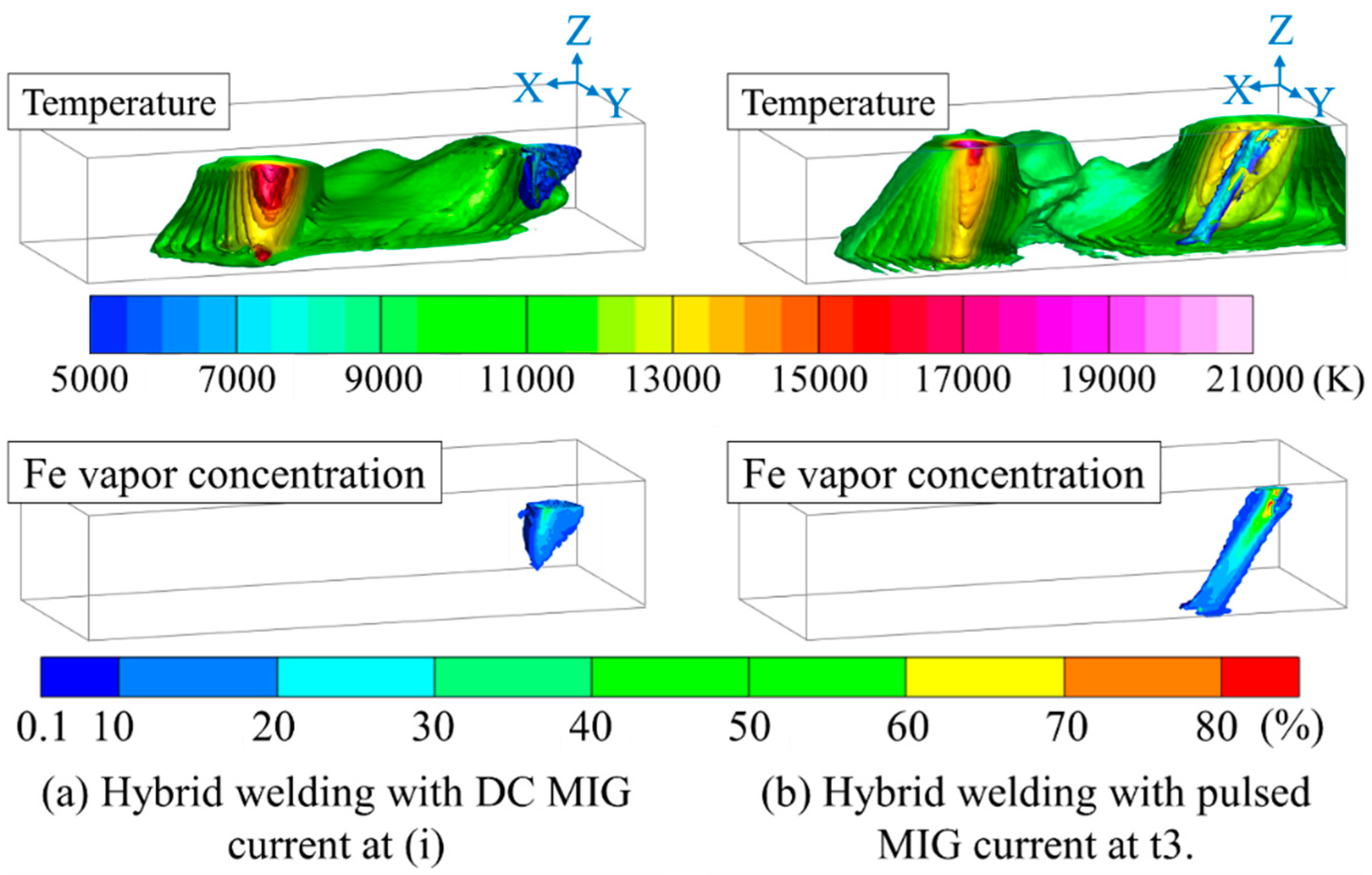
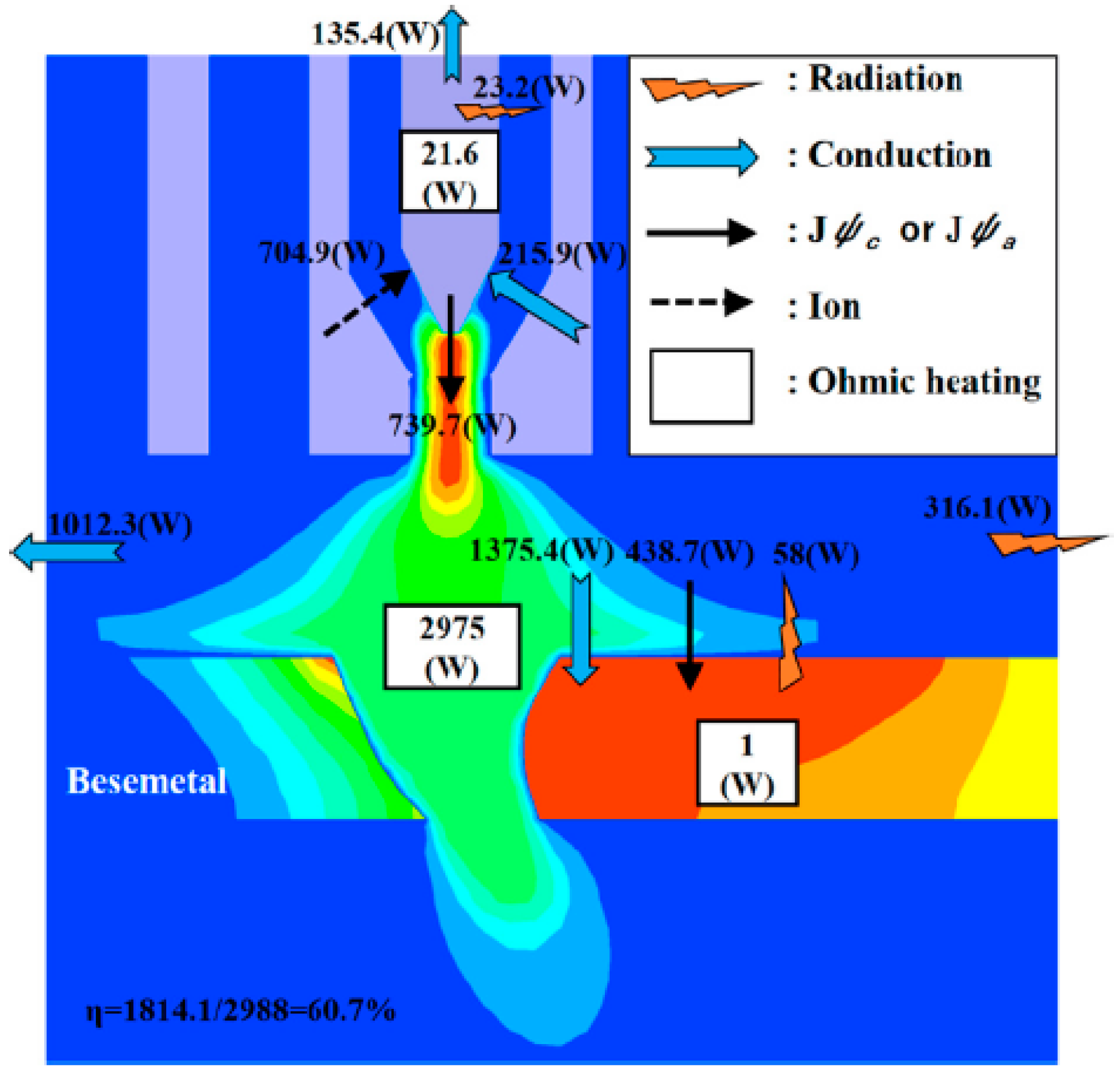
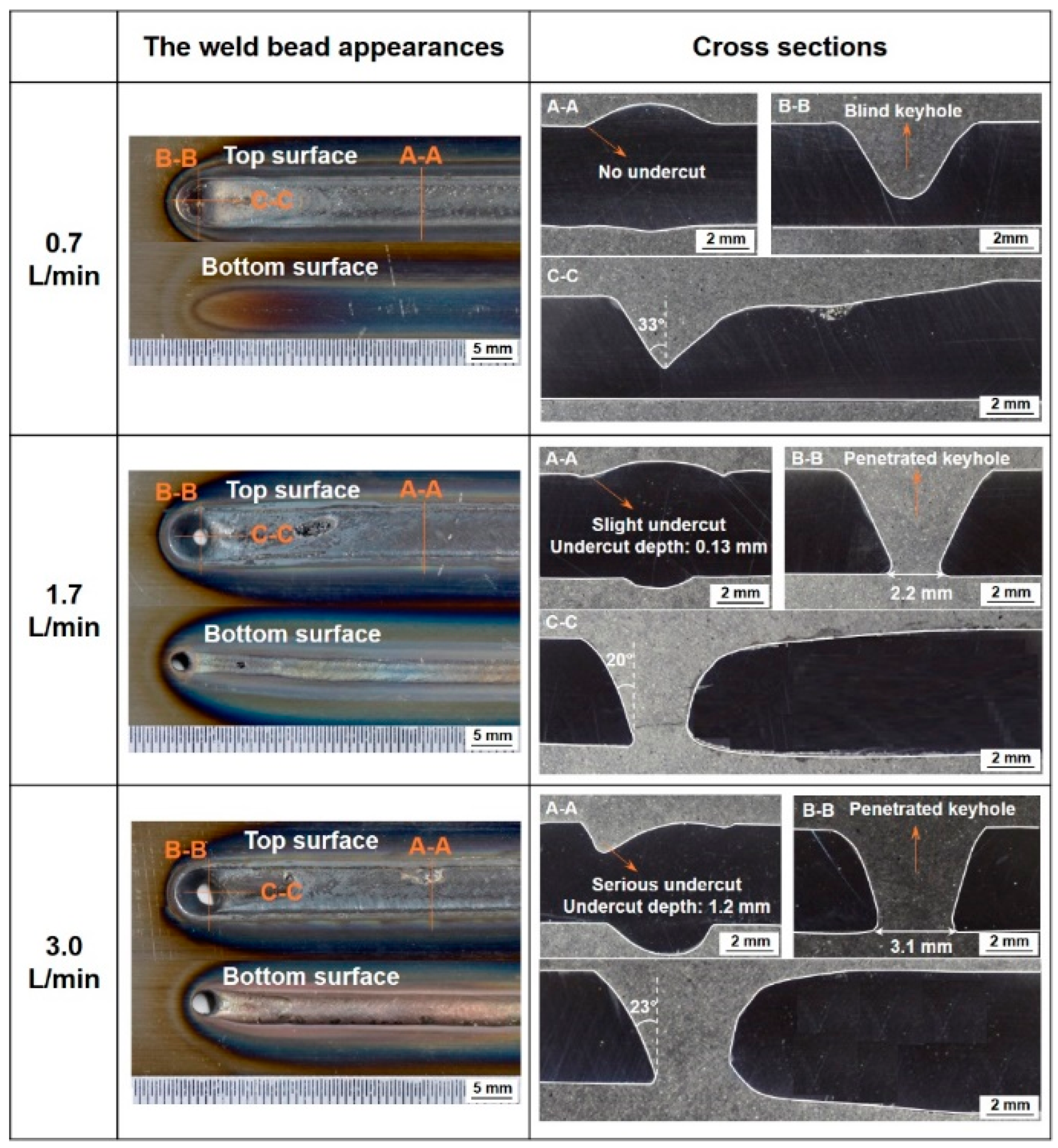
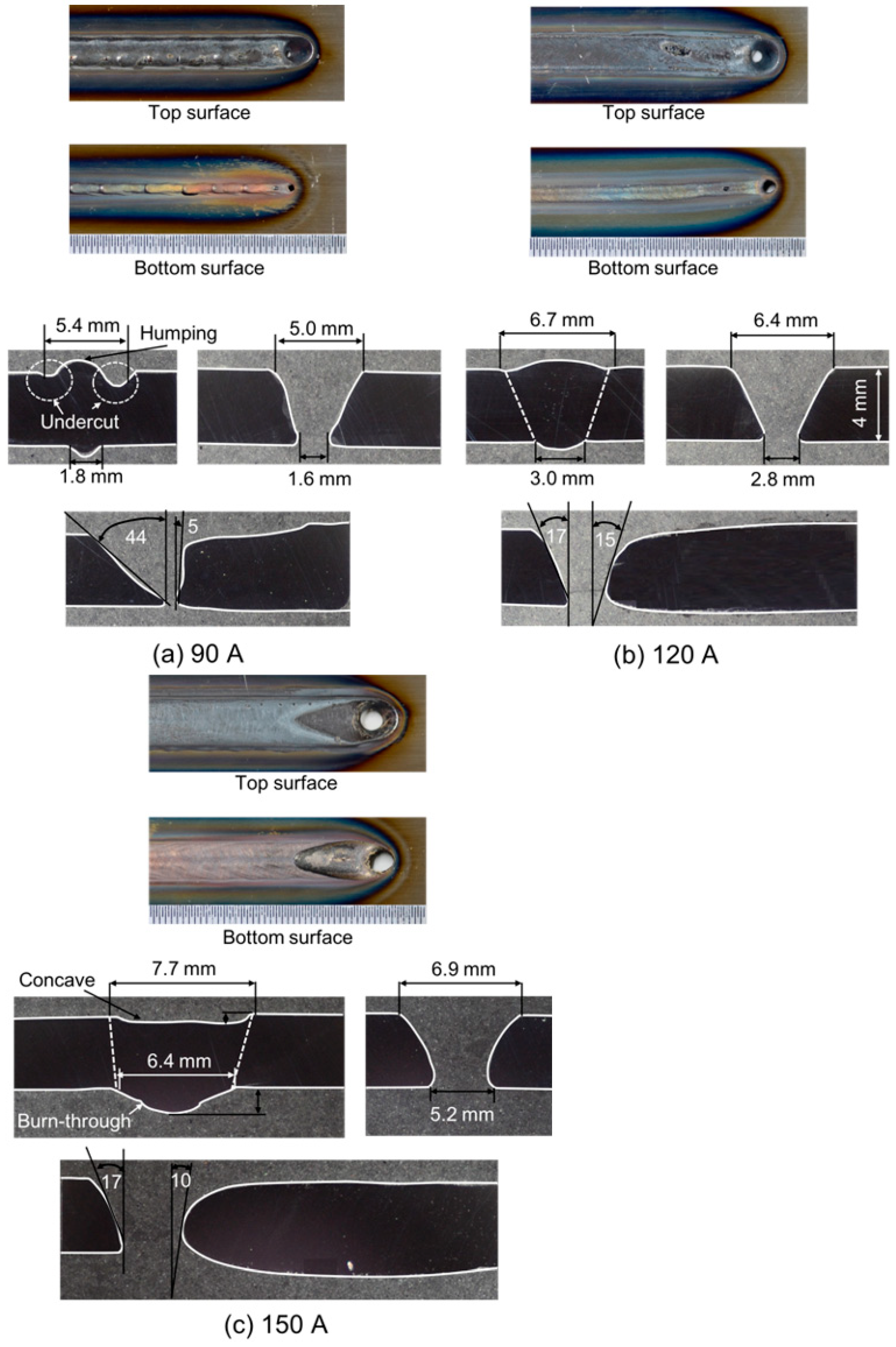
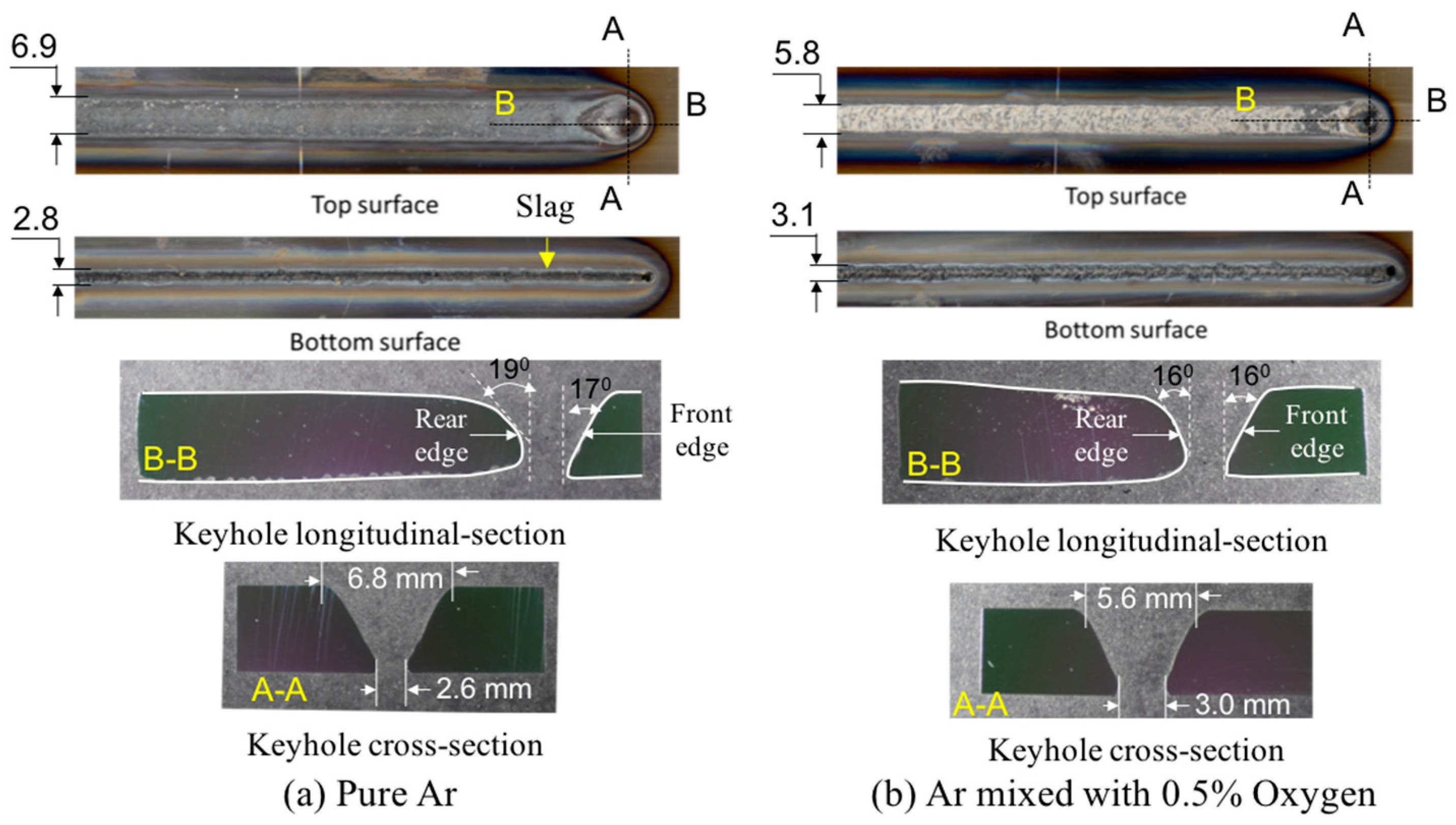
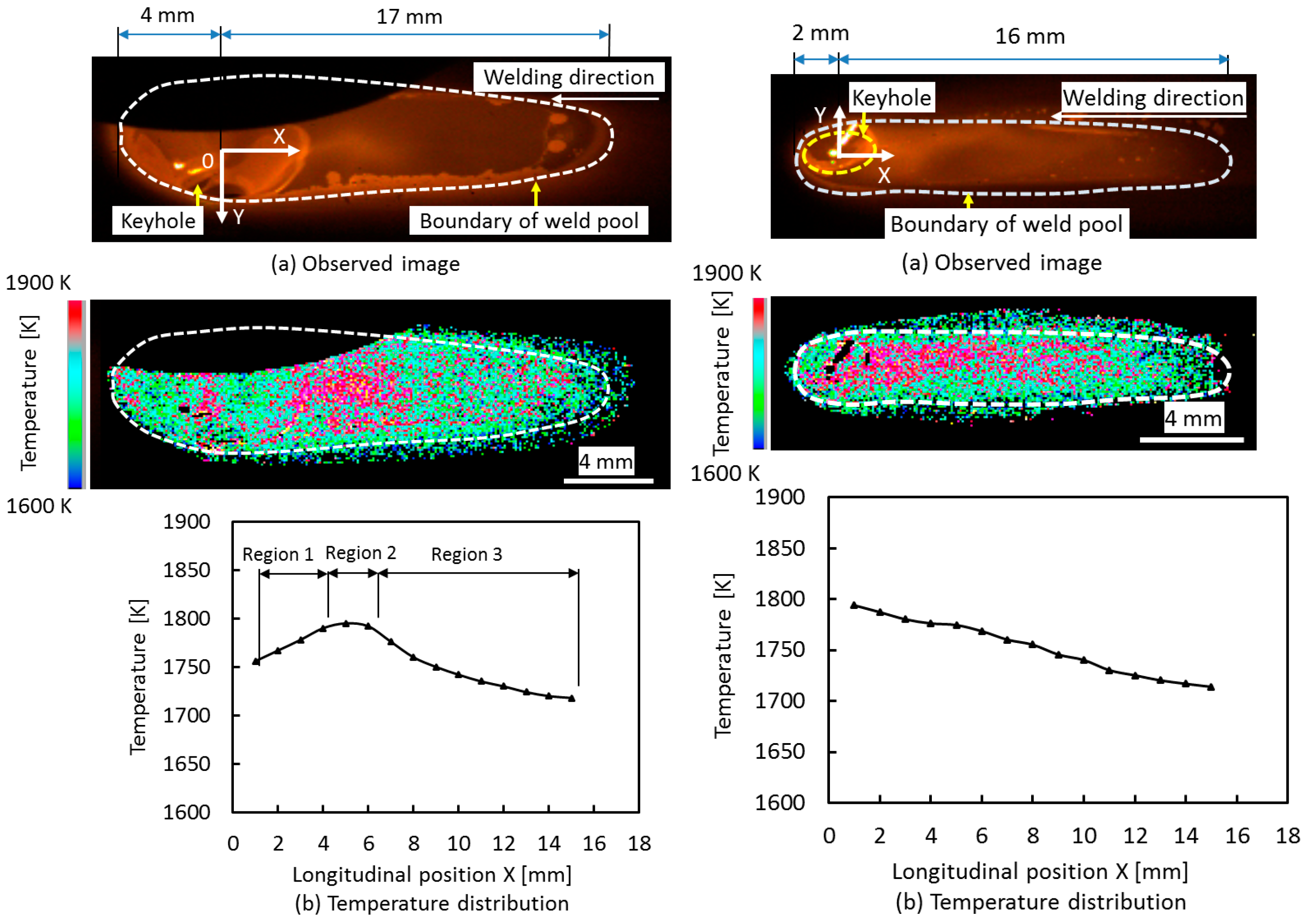


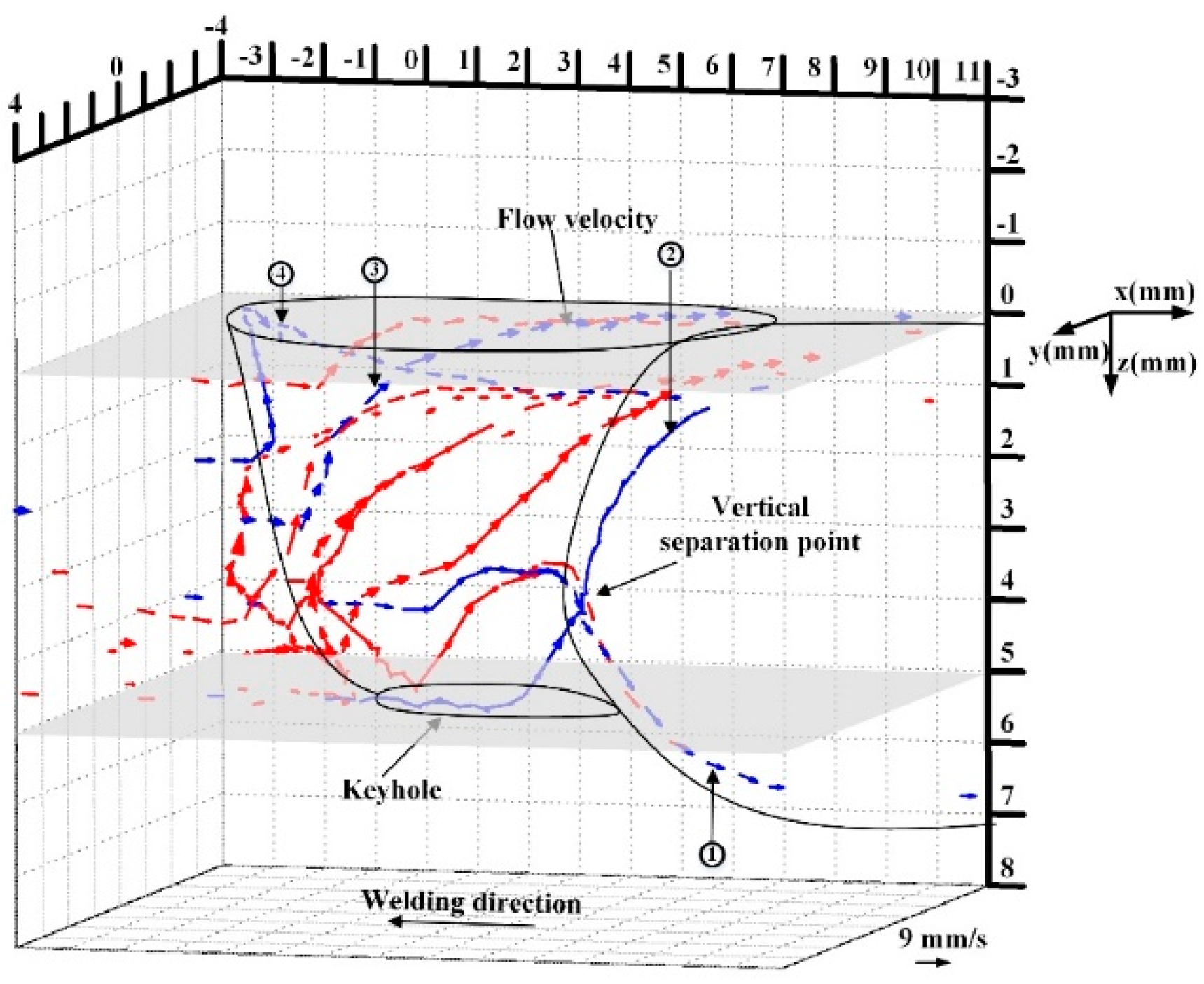

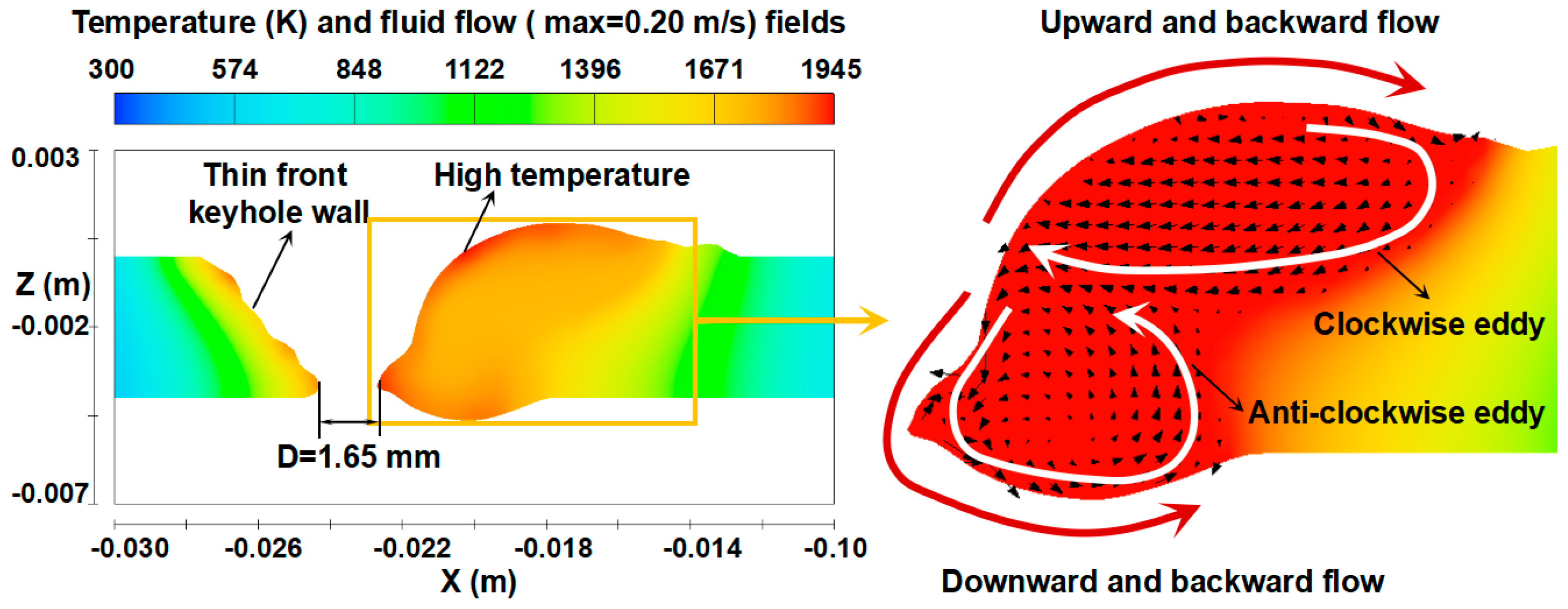
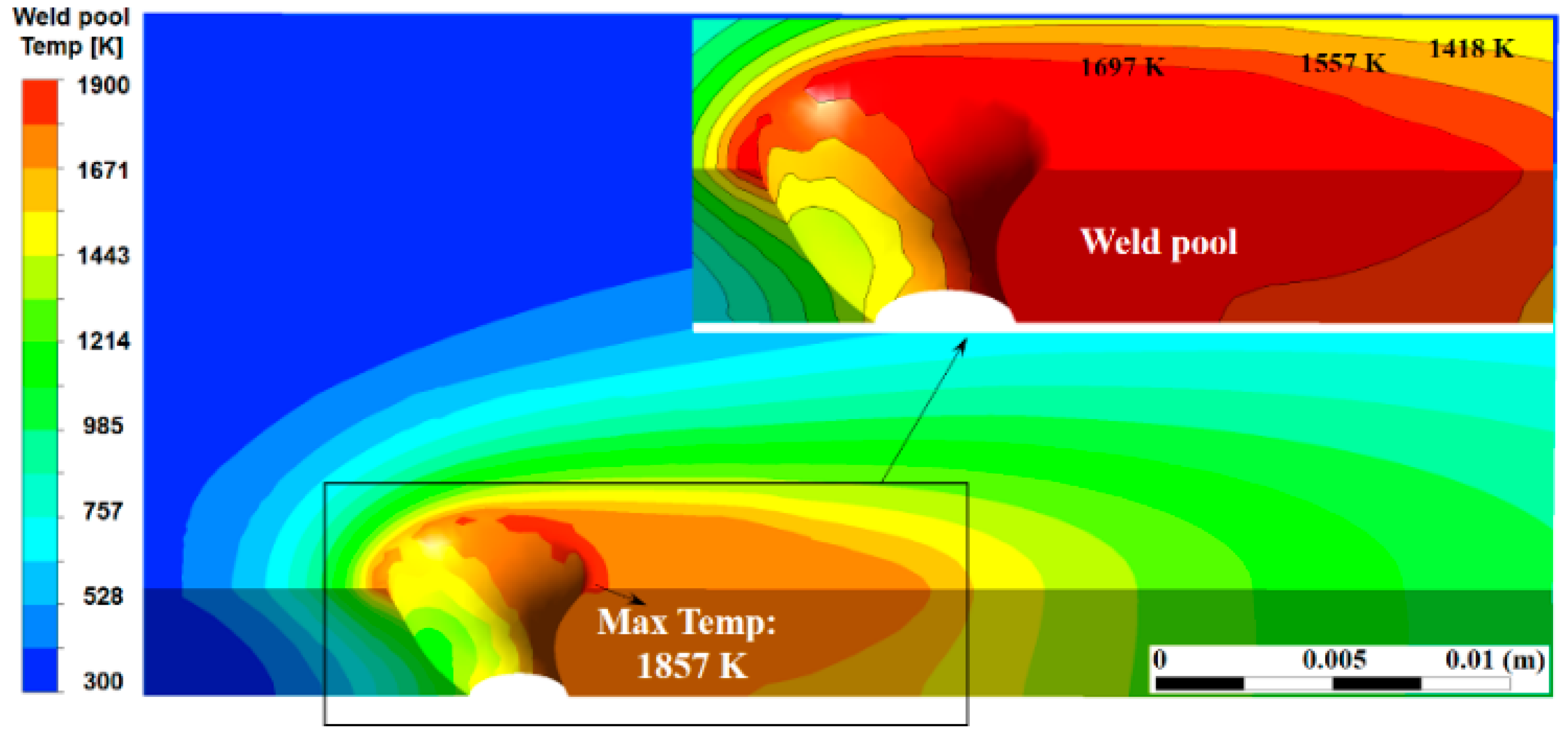
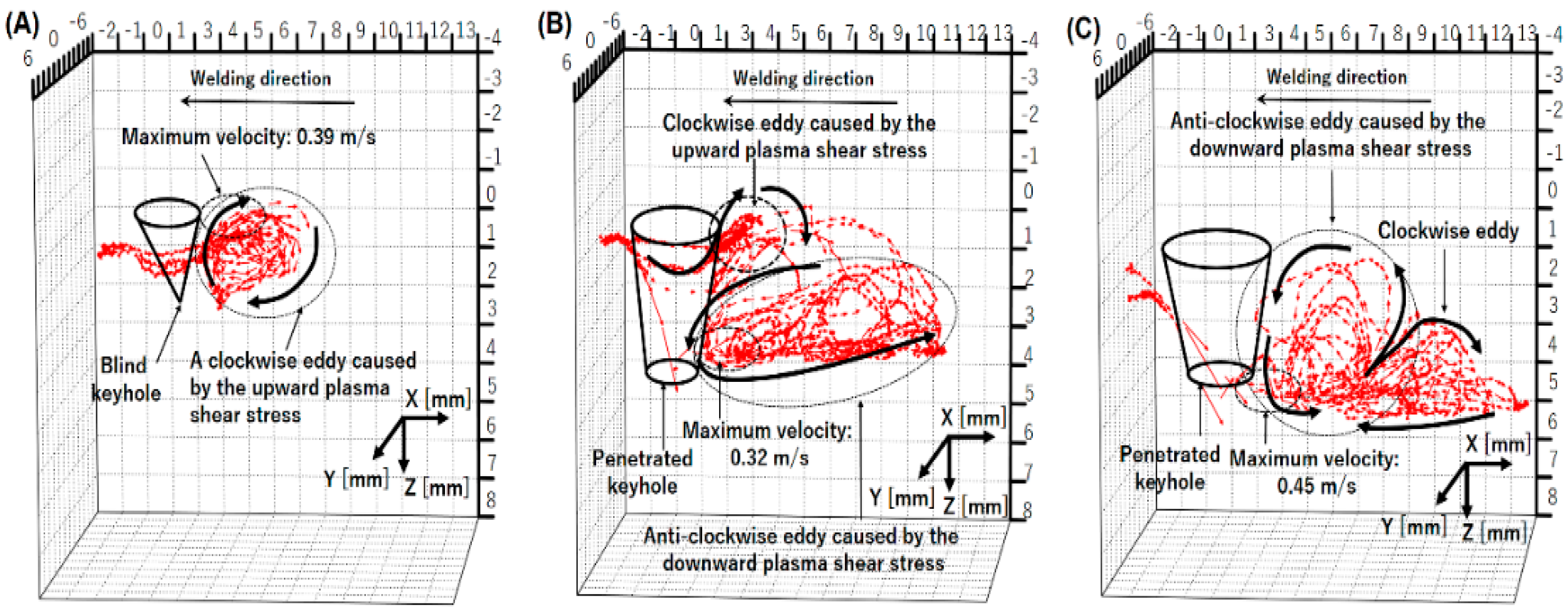
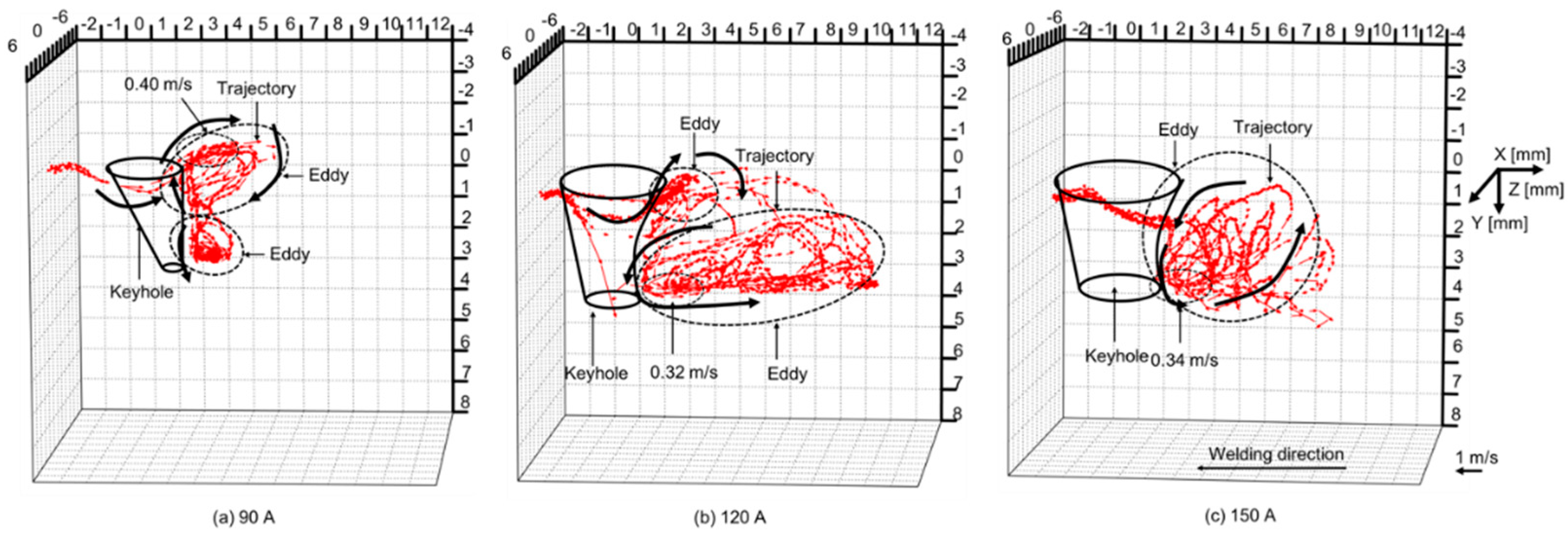
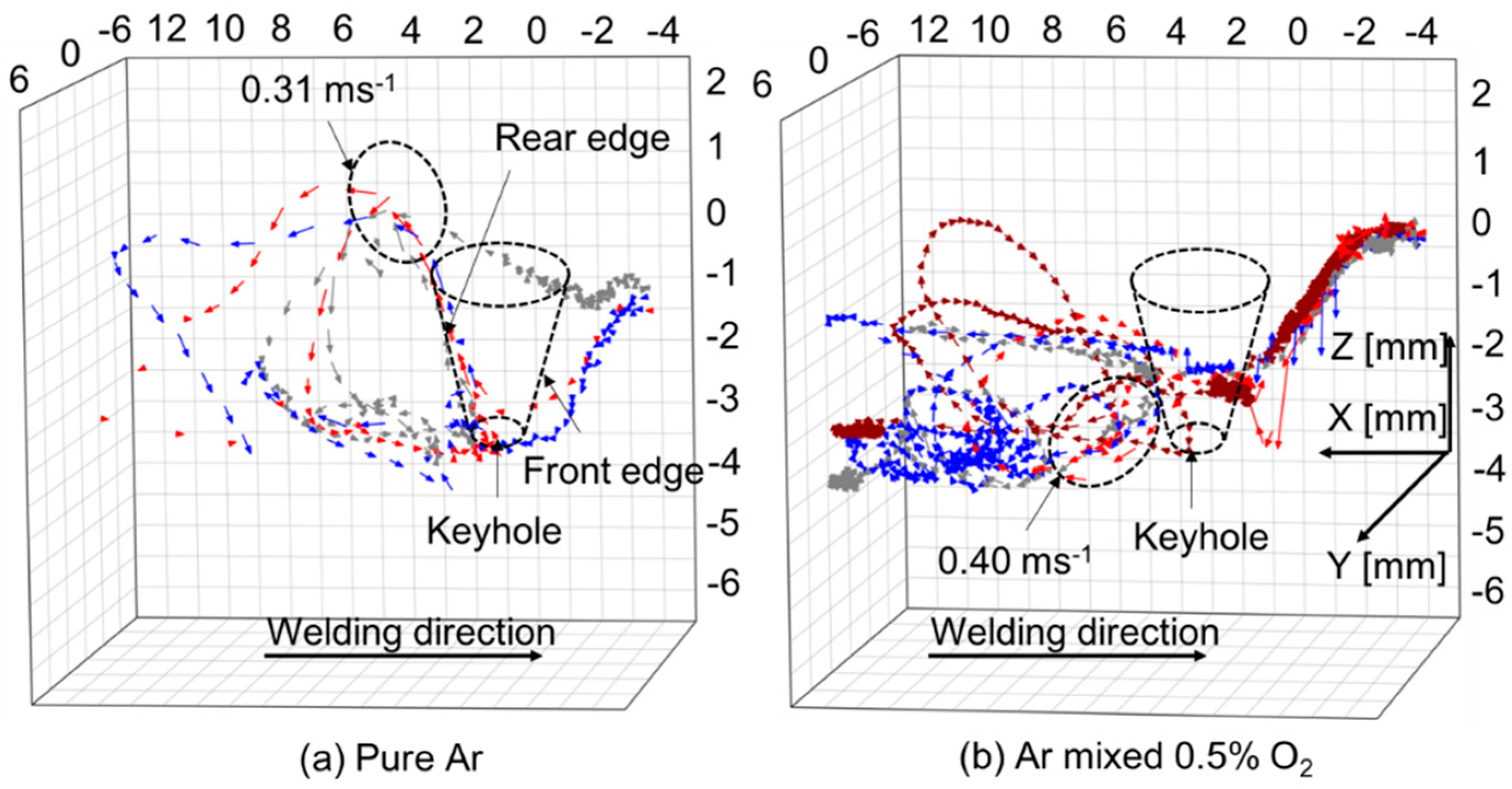
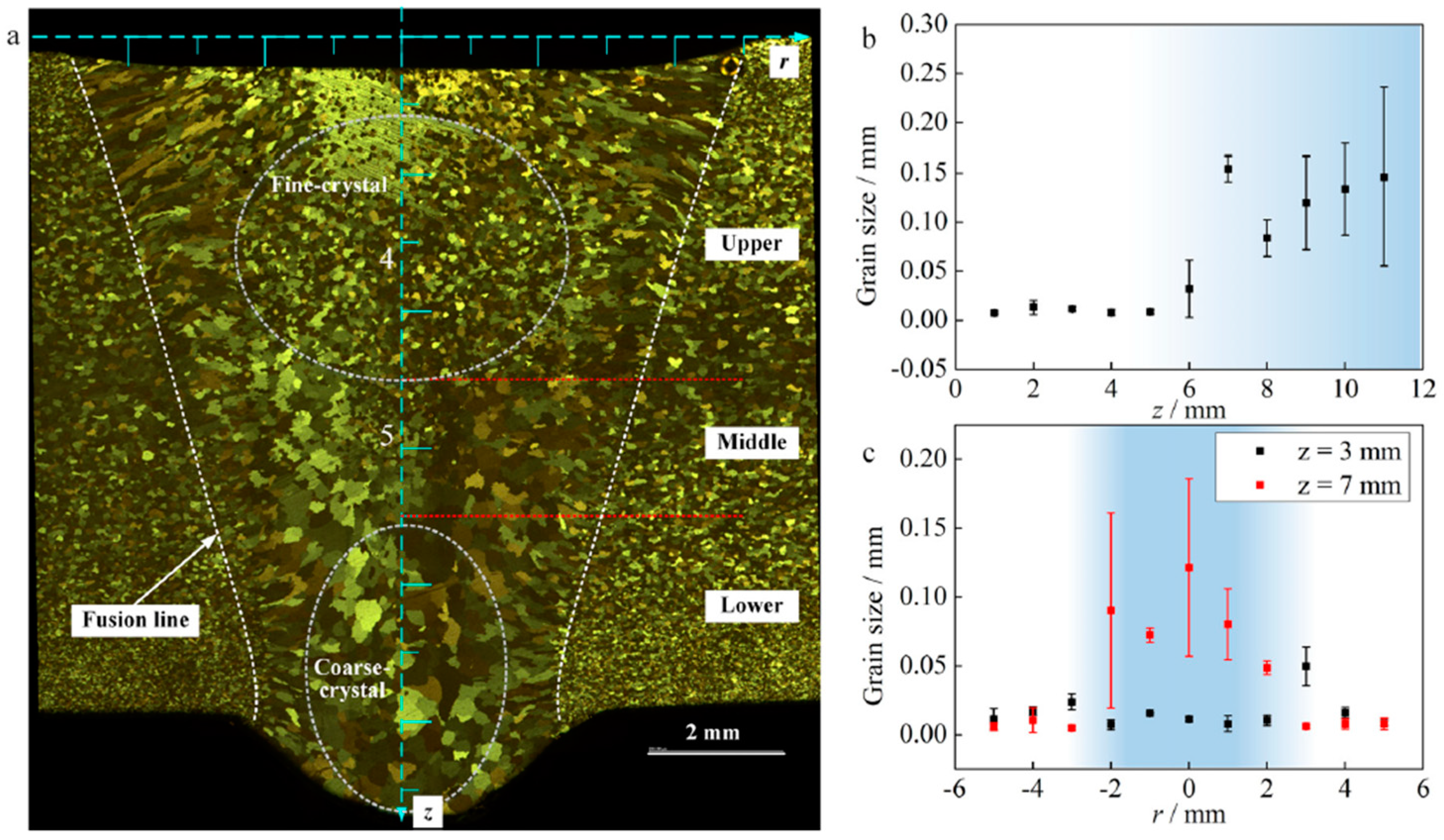
Disclaimer/Publisher’s Note: The statements, opinions and data contained in all publications are solely those of the individual author(s) and contributor(s) and not of MDPI and/or the editor(s). MDPI and/or the editor(s) disclaim responsibility for any injury to people or property resulting from any ideas, methods, instructions or products referred to in the content. |
© 2024 by the author. Licensee MDPI, Basel, Switzerland. This article is an open access article distributed under the terms and conditions of the Creative Commons Attribution (CC BY) license (https://creativecommons.org/licenses/by/4.0/).
Share and Cite
Tashiro, S. Interaction Mechanism of Arc, Keyhole, and Weld Pool in Keyhole Plasma Arc Welding: A Review. Materials 2024, 17, 1348. https://doi.org/10.3390/ma17061348
Tashiro S. Interaction Mechanism of Arc, Keyhole, and Weld Pool in Keyhole Plasma Arc Welding: A Review. Materials. 2024; 17(6):1348. https://doi.org/10.3390/ma17061348
Chicago/Turabian StyleTashiro, Shinichi. 2024. "Interaction Mechanism of Arc, Keyhole, and Weld Pool in Keyhole Plasma Arc Welding: A Review" Materials 17, no. 6: 1348. https://doi.org/10.3390/ma17061348





